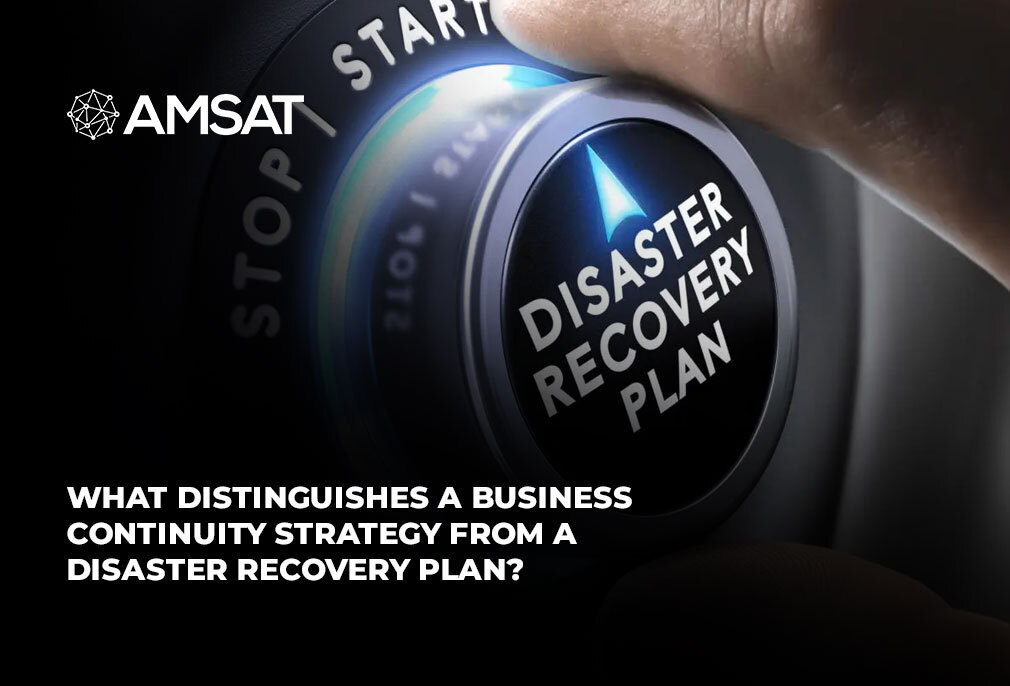Latest Blogs

By AMSAT Feb 9,2023
What Distinguishes a Business Continuity Strategy from a Disaster Recovery Plan?
The terms disaster recovery and business continuity planning are sometimes used interchangeably, but despite their similarities, they refer to two different strategies companies use to recover in the event of a disaster.
A business continuity plan emphasizes on all facets of catastrophe preparation as they pertain to avoiding a disruption of operations. A disaster recovery plan, particularly when it comes to IT systems, is more narrowly focused on the response and recovery phases of a disaster.
How and Why are a DRP and BCP Crucial?
Several threats that can hinder a business’s capacity to operate exist. Natural catastrophes like fires, floods, tornadoes, earthquakes, or hurricanes may cause them. Malware, cyberattacks, ransomware, inadvertent data deletion, and even internal sabotage are just a few examples of man-made risks. Businesses risk severe consequences by not being ready for disasters if they don’t have a business continuity plan and a disaster recovery plan in place.
How a Disaster Recovery Plan and a Business Continuity Plan Differ
In reality, when discussing a business’s catastrophe readiness, whether for prevention or reaction or both, both strategies are frequently mentioned.
It’s crucial to keep in mind that a systematic business continuity plan will already include a catastrophe recovery strategy. Your business continuity plan (BCP) is a comprehensive document that should cover all facets of a company’s disaster prevention, mitigation, and response, as well as the recovery procedures. Without considering how the company will bounce back from various crises, a business continuity strategy is useless.
Planning for Business Continuity
A business continuity plan is a comprehensive strategy to keep a company operating in the case of an emergency. In addition to drilling down to highly specific scenarios that pose hazards to operations, it focuses on the business as a whole.
In general, when you prepare for business continuity, you focus on the vital processes that must resume after a disruption so that normal operations can continue. Businesses should be able to continue operating with little disruption during or just after a disaster if the plan is implemented effectively. The needs of vendors and business partners are also a key component of the plan.
Planning for Disaster Recovery
One component of a business continuity plan that is more focused and detailed is a catastrophe recovery plan.
A disaster recovery plan may be exclusively concentrated on a company’s data and information systems, depending on who you ask.
A disaster recovery plan can also be used to describe procedures that are not IT-related. For instance, the strategy can outline how recovery staff should look for a backup facility to resume vital operations. Or, if the main lines of communication are down, instructions on how to reestablish communication between emergency personnel could be included.
Disaster recovery planning need not be solely IT-focused. Just make sure that all non-IT recovery processes are included within the larger BCP documents if your IT staff is developing an IT-focused disaster recovery plan.
The following sections are frequently needed in a business continuity plan:
- Contact information: Names and phone numbers of the people who created the BCP and/or the main recovery staff members within each department.
- Plan objectives: The general goal of the plan, including what it intends to achieve, why it is important, what areas it concentrates on, etc.
- Risk assessment: A comprehensive evaluation of disaster scenarios that potentially impair operations, categorized according to effect likelihood and/or severity.
- Impact analysis: Determining the precise effects of each disaster scenario and how much they harm the company, such as the price of idle labor, recovery expenses, hardware damage and repair, etc.
- Preventive measures and systems, such as the installation of antimalware programs to stop specific cyberattacks, are taken to avoid each of those catastrophes.
- Response: How the company should react to any disaster to lessen effects and start a quick recovery, including restoring backups after a data loss.
- Areas for improvement: Any flaws found throughout the BCP’s development, along with suggested fixes and actions to close these gaps.
- Contingencies: A list of secondary backup resources, including processes, equipment, and/or locations for backup offices and/or data centers.
Contents of a Disaster Recovery Plan
The “Response” part of your business continuity strategy is essentially your catastrophe recovery plan. It includes all the techniques, tools, and goals required to carry out a speedy recovery following a catastrophe. This recovery could be related to lost data, broken hardware, downed networks, failed applications, or practically any other point of failure within your business.
Disaster Recovery & Backup
Keeping a server at a backup location where you can access all of your data is one of the greatest disaster recovery preparation solutions. In this way, a backup of all crucial data is accessible in the event of a calamity at the primary site. How you handle and access data from the secondary site as rapidly as feasible will be determined by a sound disaster recovery plan.
In the case of hybrid cloud backup solutions, for instance, you have a variety of recovery alternatives. In the event of a disaster at the primary site, you can boot the full backup as a virtual computer or recover data via the cloud. While a full recovery is taking place, the virtualization technique enables for immediate access to data and applications.
Your disaster recovery plan’s dependability ultimately depends on all of the infrastructure, procedures, planning, and testing you’ve incorporated into it.
Frequently Asked Questions
1) What distinguishes a disaster recovery plan from a business continuity strategy?
The key distinction is that a business continuity plan focusses on the overall goal of preventing any operational delays, whereas a disaster recovery plan is more concerned with the specific steps for recovering after a calamity, mostly with relation to IT systems.
2) Disaster recovery or business continuity: which comes first?
Business continuity planning typically comes before disaster recovery planning; it is the keystone of a company’s disaster preparedness. Continuity planning will use a risk assessment and impact analysis to determine the main risks to a company. These evaluations can help with IT disaster recovery planning.
3) What are disaster recovery and business continuity?
A business’s ability to continue operating in the face of a disaster is referred to as business continuity and disaster recovery, or BC/DR. Although other IT systems are also covered by the phrase, data backup and recovery systems are where it is most frequently.
Recent Blogs
Ready to Get Started?
Our specialists are ready to tailor our security service solutions to fit the needs of your organization.










